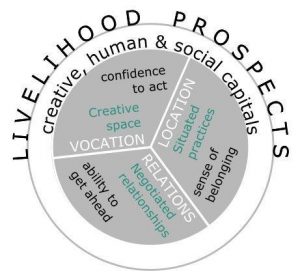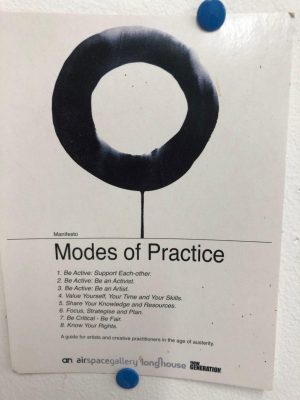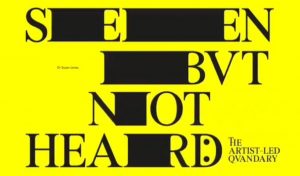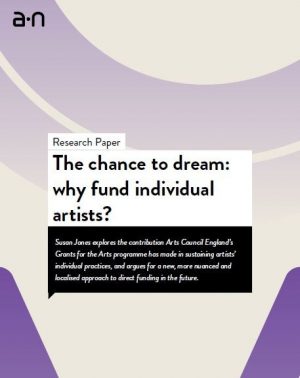Effective strategies for retaining the artist-led as a vital ingredient in social and arts well-being in future involves artists seeking out allies and synergies beyond the restrictive hierarchies of the contemporary visual arts.
Read “Seen but not heard: the artist-led quandary” in full

Conditions for motility
“This is a moment fraught with possibility.” Isabelle Tracy, Parallel State: State of the Nation podcast 27 March 2020
This text in the Covid19 portfolio is on the future of artists’ livelihoods. It starts by evidencing the impact of external trends on visual artists’ livelihoods. It then identifies some of the policy misassumptions and structural barriers that limit artists’ livelihood prospects before demonstrating that visual artists as a ‘special case’ within the arts workforce are deserving of individualised attention within arts policies. It concludes by outlining the core qualities for pursuit of livelihoods through art practices that enable many artists to contribute to society over a life-cycle as a point of reference for policy-making during the Covid19 emergency and into the uncertain decade ahead.
Read “From myths to motility: doing better by artists” in full
Although not a major aspect of artists’ livelihoods, grants and awards to artists are a vital contributor to sustaining art practices over a life-cycle. This paper starts by outlining the benefits of direct funding to individual artists, describes differing arts policy perspectives on this in England over the last thirty years and provides a case study of Arts Council England’s Grants for the Arts Scheme 2003 – 14 before making an argument for new, nuanced, localised approaches to nurturing and supporting the wider constituency of visual artists and diversity of art practices in future.
Read “The chance to dream: why fund individual artists?” in full
A provocation around the role and value of and expectations for artists within cultural and social change. Rather than expecting others to articulate artists’ value on their behalf, I am proposing that artists take responsibility themselves for this and for advocating for and translating their value to others.
Read “"Nobody wants you but everyone needs you"” in full
Drawing on past UK evidence , this essay provides analysis how the landscape and drivers for artists’ residencies have changed and insight to inform more productive residency practices within future arts policies.
Read “Residencies: practices and paradoxes” in full

Cover: Working artists aspect of arts and labour
This essay for the 2014 Seoul Art Space, Seoul Foundation for Arts and Culture International Symposium briefly covers UK arts policies for support to artists’ development, comments on their impact on artists’ social and economic status and suggests a rethinking of the artists’ intrinsic role in society as a vital part of securing and sustaining contemporary visual arts in the future.
Read “Rethinking artists: the role of artists in the 21st Century” in full

Modes of practice postcard
This provocation commissioned by Stoke Airspace for an Artists’ Soup Kitchen addresses and confirms the importance of the role and value of artists within cultural and social change. The four sections are designed to open up a discussion on ‘what now?’ and – more importantly – ‘what next?’ for Airspace and artists and future artists located in Stoke.
Read “Bite the hand that feeds you” in full
In reaction to government arts funding cuts, Leeds Metropolitan University in partnership with Culture Vulture and the Audience Agency, initiated a public debate at which a panel of industry experts debated what arts funding is for and who is most deserving of it. A short provocation by Susan Jones argued for more recognition and resources for artists and individuals to counteract the slow, ponderousness of institutions whether for the arts or otherwise. View the whole event including the audience ‘question time’ at the end using the link provided.
Read “A case for the arts” in full




